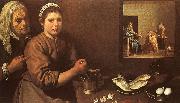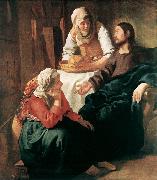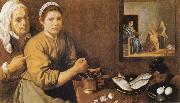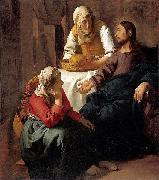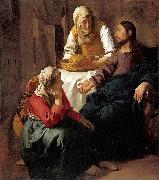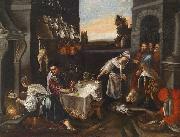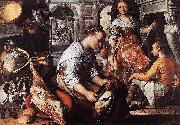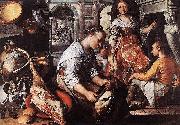Wholesale Oil Painting No Minimum |
|||||||||||
|
|
|||||||||||

|
|||||||||||
|
|
|
||||||||
Diego VelazquezSpanish Baroque Era Painter, 1599-1660 Spanish painter. He was one of the most important European artists of the 17th century, spending his career from 1623 in the service of Philip IV of Spain. His early canvases comprised bodegones and religious paintings, but as a court artist he was largely occupied in executing portraits, while also producing some historical, mythological and further religious works. His painting was deeply affected by the work of Rubens and by Venetian artists, especially Titian, as well as by the experience of two trips (1629-31 and 1649-51) to Italy. Under these joint influences he developed a uniquely personal style characterized by very loose, expressive brushwork. Although he had no immediate followers, he was greatly admired by such later painters as Goya and Manet |
||||||||
|
|
||||||||
Christ in the House of Martha and Mary
Christ in the House of Martha and Mary Painting ID:: 738 |
National Gallery, London National Gallery, London |
|||||||
|
|
||||||||
Jan VermeerDutch Baroque Era Painter, 1632-1675 Johannes (or Jan) Vermeer is now recognized as one of the great Dutch painters, but while he was alive he could barely make ends meet, and his artistic achievement was almost entirely ignored for 200 years after his death. Little is known about his personal life, other than he died poor and young and left behind a wife and eleven children. Vermeer is admired for his realistic style, his subtle use of color and light and his unusual and inventive brush technique, but fewer than forty of his paintings exist. His most famous works include domestic scenes such as Girl With a Peal Earring (1665) and The Music Lesson (1662-65), and tranquil landscapes such as The Little Street (1657-58) and View of Delft (1659-60). Although his actual birth and death dates are unknown, Vermeer was baptized 31 October 1632 and buried 15 December 1675... During his career he used the names Johannes van der Meer, Johannes Vermeer and Jan Vermeer |
||||||||
|
|
||||||||
|
|
Christ in the House of Martha and Mary
Christ in the House of Martha and Mary Painting ID:: 10260 |
1654Oil on canvas
160 x 142 cm
National Gallery
of Scotland 1654Oil on canvas 160 x 142 cm National Gallery of Scotland |
||||||
|
|
||||||||
Diego VelazquezSpanish Baroque Era Painter, 1599-1660 Spanish painter. He was one of the most important European artists of the 17th century, spending his career from 1623 in the service of Philip IV of Spain. His early canvases comprised bodegones and religious paintings, but as a court artist he was largely occupied in executing portraits, while also producing some historical, mythological and further religious works. His painting was deeply affected by the work of Rubens and by Venetian artists, especially Titian, as well as by the experience of two trips (1629-31 and 1649-51) to Italy. Under these joint influences he developed a uniquely personal style characterized by very loose, expressive brushwork. Although he had no immediate followers, he was greatly admired by such later painters as Goya and Manet |
||||||||
|
|
||||||||
|
|
Christ in the House of Martha and Mary
Christ in the House of Martha and Mary Painting ID:: 33641 |
mk86
1618
Oil on canvas
60x103.5cm
London,National Gallery
mk86 1618 Oil on canvas 60x103.5cm London,National Gallery |
||||||
|
|
||||||||
Johannes VermeerOne of the most talented painters in the Dutch Golden Age , 1632-1675 was a Dutch Baroque painter who specialized in exquisite, domestic interior scenes of ordinary life. Vermeer was a moderately successful provincial genre painter in his lifetime. He seems never to have been particularly wealthy, perhaps because he produced relatively few paintings, leaving his wife and children in debt at his death. Vermeer worked slowly and with great care, using bright colours, sometimes expensive pigments, with a preference for cornflower blue. He is particularly renowned for his masterly treatment and use of light in his work. What strikes in most of his paintings is a certain love, which easily could be called a love sickness, for the people and the objects in his paintings. He created a world more perfect than any he had witnessed. After having been virtually forgotten for nearly one hundred years, |
||||||||
|
|
||||||||
|
|
Christ in the House of Martha and Mary
Christ in the House of Martha and Mary Painting ID:: 68479 |
before 1655(1655)
Oil on canvas
160 ?? 142 cm (62.99 ?? 55.91 in)
before 1655(1655) Oil on canvas 160 ?? 142 cm (62.99 ?? 55.91 in) |
||||||
|
|
||||||||
Johannes VermeerOne of the most talented painters in the Dutch Golden Age , 1632-1675 was a Dutch Baroque painter who specialized in exquisite, domestic interior scenes of ordinary life. Vermeer was a moderately successful provincial genre painter in his lifetime. He seems never to have been particularly wealthy, perhaps because he produced relatively few paintings, leaving his wife and children in debt at his death. Vermeer worked slowly and with great care, using bright colours, sometimes expensive pigments, with a preference for cornflower blue. He is particularly renowned for his masterly treatment and use of light in his work. What strikes in most of his paintings is a certain love, which easily could be called a love sickness, for the people and the objects in his paintings. He created a world more perfect than any he had witnessed. After having been virtually forgotten for nearly one hundred years, |
||||||||
|
|
||||||||
|
|
Christ in the House of Martha and Mary
Christ in the House of Martha and Mary Painting ID:: 70738 |
Medium Oil on canvas
Dimensions Expression error: Missing operand for *160 ?? 142 cm
Medium Oil on canvas Dimensions Expression error: Missing operand for *160 ?? 142 cm |
||||||
|
|
||||||||
Follower of Jacopo da Pontepainted Christ in the house of Martha and Mary in 16th/17th century |
||||||||
|
|
||||||||
|
|
Christ in the house of Martha and Mary
Christ in the house of Martha and Mary Painting ID:: 81851 |
Christ in the house of Martha and Mary; Oil on canvas, 96 x 123 cm; after the copperplate print by Jan Sadeler (1598) after a paintings of Jacopo Bassano
Date 16th/17th century
Christ in the house of Martha and Mary; Oil on canvas, 96 x 123 cm; after the copperplate print by Jan Sadeler (1598) after a paintings of Jacopo Bassano Date 16th/17th century |
||||||
|
|
||||||||
Joachim Beuckelaer1535-1574 Flemish Joachim Beuckelaer Galleries b Antwerp, c. 1534; dAntwerp, c. 1574). Flemish painter. He came from an Antwerp family of obscure painters and seems to have spent his entire life there. He trained in the studio of Pieter Aertsen, who in 1542 had married Beuckelaers aunt; he became an independent master and also married in 1560. His earliest known work dates from that year, and his development can be followed closely to 1570. The example of Beuckelaers master remained decisive throughout his career. Not only did he take over Aertsens new repertory of secular subjects, he also completely adopted his stylistic idiom and manner of painting, so that it can be difficult to distinguish the two hands. Beuckelaer was, however, by no means a slavish imitator, and as regards execution he fully bears comparison with Aertsen. |
||||||||
|
|
||||||||
|
|
Christ in the House of Martha and Mary
Christ in the House of Martha and Mary Painting ID:: 84573 |
Date 1565(1565)
Medium Oil on oak
Dimensions Height: 113 cm (44.5 in). Width: 163 cm (64.2 in).
cjr Date 1565(1565) Medium Oil on oak Dimensions Height: 113 cm (44.5 in). Width: 163 cm (64.2 in). cjr |
||||||
|
|
||||||||
Joachim Beuckelaer1535-1574 Flemish Joachim Beuckelaer Galleries b Antwerp, c. 1534; dAntwerp, c. 1574). Flemish painter. He came from an Antwerp family of obscure painters and seems to have spent his entire life there. He trained in the studio of Pieter Aertsen, who in 1542 had married Beuckelaers aunt; he became an independent master and also married in 1560. His earliest known work dates from that year, and his development can be followed closely to 1570. The example of Beuckelaers master remained decisive throughout his career. Not only did he take over Aertsens new repertory of secular subjects, he also completely adopted his stylistic idiom and manner of painting, so that it can be difficult to distinguish the two hands. Beuckelaer was, however, by no means a slavish imitator, and as regards execution he fully bears comparison with Aertsen. |
||||||||
|
|
||||||||
|
|
Christ in the House of Martha and Mary
Christ in the House of Martha and Mary Painting ID:: 88435 |
1565(1565)
Medium Oil on oak
cyf 1565(1565) Medium Oil on oak cyf |
||||||
|
|
||||||||
|
Joachim Beuckelaer 1535-1574 Flemish Joachim Beuckelaer Galleries b Antwerp, c. 1534; dAntwerp, c. 1574). Flemish painter. He came from an Antwerp family of obscure painters and seems to have spent his entire life there. He trained in the studio of Pieter Aertsen, who in 1542 had married Beuckelaers aunt; he became an independent master and also married in 1560. His earliest known work dates from that year, and his development can be followed closely to 1570. The example of Beuckelaers master remained decisive throughout his career. Not only did he take over Aertsens new repertory of secular subjects, he also completely adopted his stylistic idiom and manner of painting, so that it can be difficult to distinguish the two hands. Beuckelaer was, however, by no means a slavish imitator, and as regards execution he fully bears comparison with Aertsen. Christ in the House of Martha and Mary 1565(1565) Medium Oil on oak cyf |
||||||||
|
|
||||||||
|
Prev Next
|
||||||||
|
|
||||||||
|
Related Paintings to Joachim Beuckelaer :. |
||||||||
|
|
||||||||
|
CONTACT US |
